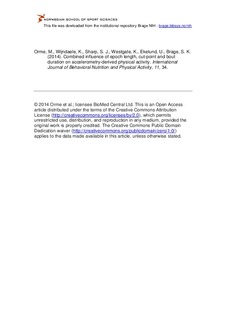| dc.contributor.author | Orme, Mark | |
| dc.contributor.author | Wijndaele, Katrien | |
| dc.contributor.author | Sharp, Stephen J. | |
| dc.contributor.author | Westgate, Kate | |
| dc.contributor.author | Ekelund, Ulf | |
| dc.contributor.author | Brage, Søren | |
| dc.date.accessioned | 2015-06-03T08:05:48Z | |
| dc.date.available | 2015-06-03T08:05:48Z | |
| dc.date.issued | 2014-03-10 | |
| dc.identifier.citation | International Journal of Behavioral Nutrition and Physical Activity. 2014, 11, 34 | nb_NO |
| dc.identifier.uri | http://hdl.handle.net/11250/284469 | |
| dc.description | © 2014 Orme et al.; licensee BioMed Central Ltd. This is an Open Access article distributed under the terms of the Creative Commons Attribution License (http://creativecommons.org/licenses/by/2.0), which permits unrestricted use, distribution, and reproduction in any medium, provided the original work is properly credited. The Creative Commons Public Domain Dedication waiver (http://creativecommons.org/publicdomain/zero/1.0/) applies to the data made available in this article, unless otherwise stated. | nb_NO |
| dc.description.abstract | Background: It is difficult to compare accelerometer-derived estimates of moderate-to-vigorous physical activity (MVPA) between studies due to differences in data processing procedures. We aimed to evaluate the effects of accelerometer processing options on total and bout-accumulated time spent in MVPA in adults.
Methods: 267 participants from the ProActive Trial provided 1236 days of valid physical activity (PA) data, collected using a 5-s epoch with ActiGraph GT1M accelerometers. We integrated data over 5-s to 60-s epoch lengths (EL) and applied two-level mixed effects regression models to MVPA time, defined using 1500 to 2500 counts/minute (cpm) cut-points (CP) and bout durations (BD) from 1 to 15 min.
Results: Total MVPA time was lower on longer EL and higher CP (47 vs 26 min/day and 26 vs 5 min/day on 1500 vs 2500 cpm on 5-s and 60-s epoch, respectively); this could be approximated as MVPA = exp[2.197 + 0.279*log(CP) + 6.120*log(EL) - 0.869*log(CP)*log(EL)] with an 800 min/day wear-time. In contrast, EL was positively associated with time spent in bout-accumulated MVPA; the approximating equation being MVPA = exp[54.679 - 6.268*log(CP) + 6.387*log(EL) - 10.000*log(BD) - 0.162*log(EL)*log(BD) - 0.626*log(CP)*log(EL) + 1.033*log(CP)*log(BD)]. BD and CP were inversely associated with MVPA, with higher values attenuating the influence of EL.
Conclusions: EL, CP and BD interact to influence estimates of accelerometer-determined MVPA. In general, higher CP and longer BD result in lower MVPA but the direction of association for EL depends on BD. Reporting scaling coefficients for these key parameters across their frequently used ranges would facilitate comparisons of population-level accelerometry estimates of MVPA. | nb_NO |
| dc.language.iso | eng | nb_NO |
| dc.publisher | BioMed Central | nb_NO |
| dc.subject | moderate-to-vigorous | nb_NO |
| dc.subject | adults | nb_NO |
| dc.subject | measurement | nb_NO |
| dc.subject | wear-time | nb_NO |
| dc.subject | actigraph | nb_NO |
| dc.subject | objective | nb_NO |
| dc.title | Combined influence of epoch length, cut-point and bout duration on accelerometry-derived physical activity | nb_NO |
| dc.type | Journal article | nb_NO |
| dc.type | Peer reviewed | nb_NO |
| dc.subject.nsi | VDP::Social science: 200::Social science in sports: 330 | nb_NO |
| dc.subject.nsi | VDP::Medical disciplines: 700::Sports medicine: 850 | nb_NO |
| dc.source.journal | International Journal of Behavioral Nutrition and Physical Activity | nb_NO |
| dc.description.localcode | Seksjon for idretssmedisinske fag / Department of Sports Medicine | nb_NO |
